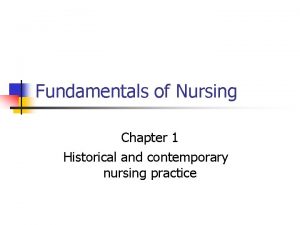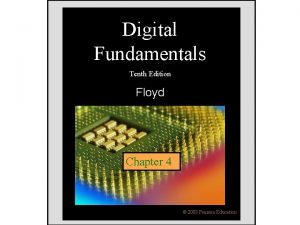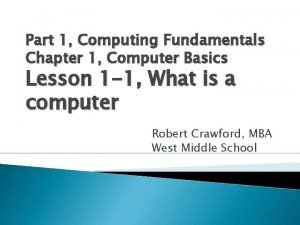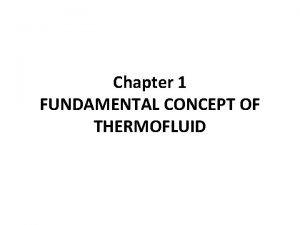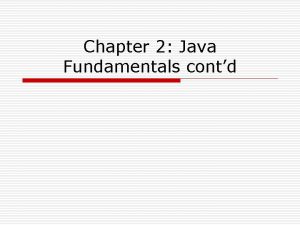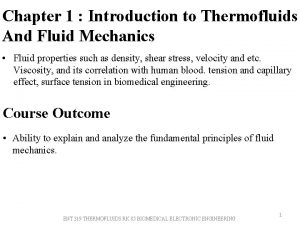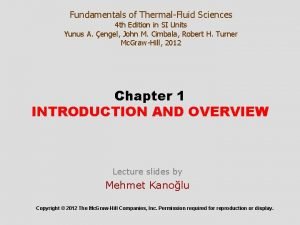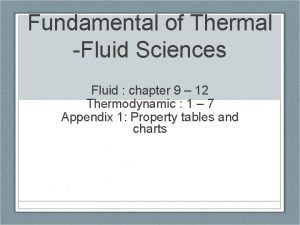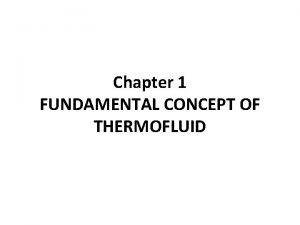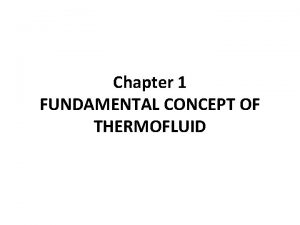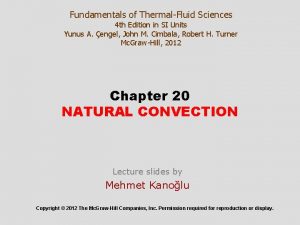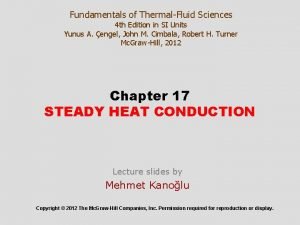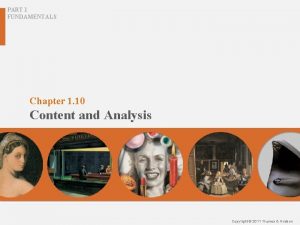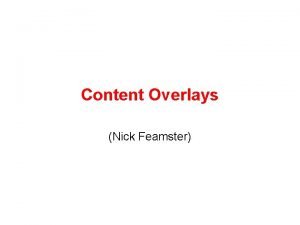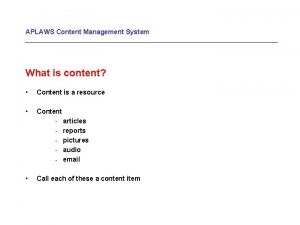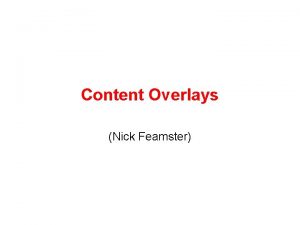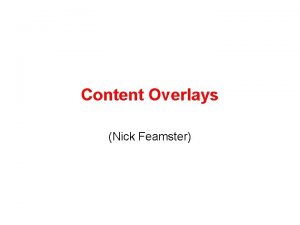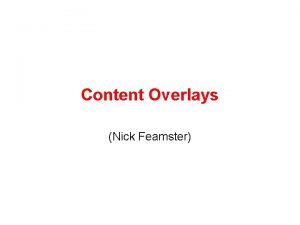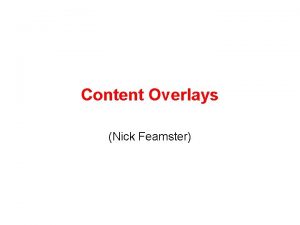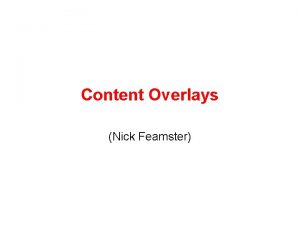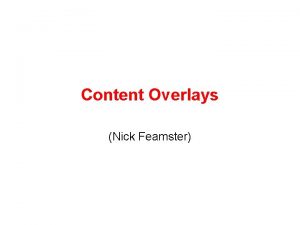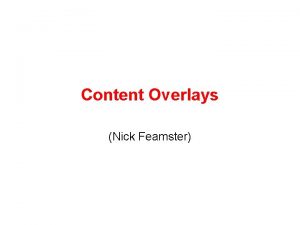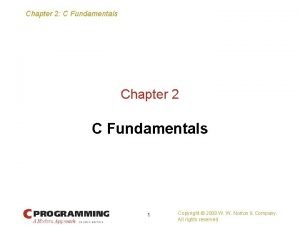PART 1 FUNDAMENTALS Chapter 1 10 Content and










































- Slides: 42

PART 1 FUNDAMENTALS Chapter 1. 10 Content and Analysis Copyright © 2011 Thames & Hudson

Chapter 1. 10 Content and Analysis PART 1 FUNDAMENTALS Introduction § The artist uses a visual language to communicate ideas, beliefs, emotions, and opinions § Content: Subject § Analysis: Finding meaning § Imitation and individual style u Learning from the masters u Developing a unique style Gateways to Art: Understanding the Visual Arts, Debra J. De. Witte, Ralph M. Larmann, M. Kathryn Shields

Chapter 1. 10 Content and Analysis PART 1 FUNDAMENTALS Content § Content refers to the meaning and the subject of a work of art § Identifying the subject of an artwork: u Representational (one can identify the subject) u Non-objective (unrecognizable subject matter) § Abstraction Gateways to Art: Understanding the Visual Arts, Debra J. De. Witte, Ralph M. Larmann, M. Kathryn Shields

1. 161 Equestrian statue of Marcus Aurelius, c. 175 CE. Bronze, 11’ 6” high. Musei Capitolini, Rome, Italy

Chapter 1. 10 Content and Analysis PART 1 FUNDAMENTALS Equestrian statue of Marcus Aurelius § Representational u Recognizable as a man on a horse u Artist tries to create realistic movement and expressions Gateways to Art: Understanding the Visual Arts, Debra J. De. Witte, Ralph M. Larmann, M. Kathryn Shields

1. 162 José de Rivera, Infinity, 1967. Stainless steel sculpture in front of National Museum of American History, Smithsonian Institution, Washington, D. C.

Chapter 1. 10 Content and Analysis PART 1 FUNDAMENTALS José de Rivera, Infinity § Non-objective u u Unrecognizable subject matter Subjective: individual viewer creates his or her own interpretation Gateways to Art: Understanding the Visual Arts, Debra J. De. Witte, Ralph M. Larmann, M. Kathryn Shields

1. 163 Allan Houser, Reverie, 1981. Bronze, 25 x 23 x 13”, edition of 10. Allan Houser Archives

Chapter 1. 10 Content and Analysis PART 1 FUNDAMENTALS Allan Houser, Reverie § Representational u u Can identify two faces Size of faces and positioning of forms suggest mother and child § Abstraction u u To emphasize, distort or simplify forms The degree to which an artwork is less representational and moves toward non-objective Gateways to Art: Understanding the Visual Arts, Debra J. De. Witte, Ralph M. Larmann, M. Kathryn Shields

Chapter 1. 10 Content and Analysis PART 1 FUNDAMENTALS Modes of Analysis § Iconographic § Biographical § Feminist § Contextual § Psychological § Formal (or visual) Gateways to Art: Understanding the Visual Arts, Debra J. De. Witte, Ralph M. Larmann, M. Kathryn Shields

Chapter 1. 10 Content and Analysis PART 1 FUNDAMENTALS Iconographic Analysis § Interprets signs and symbols within an artwork § Historical and religious references Gateways to Art: Understanding the Visual Arts, Debra J. De. Witte, Ralph M. Larmann, M. Kathryn Shields

1. 164 Audrey Flack, Marilyn Monroe, 1977. Oil over acrylic on canvas, 8 x 8’. Collection of the University of Arizona Museum of Art, Tucson

Chapter 1. 10 Content and Analysis PART 1 FUNDAMENTALS Audrey Flack, Marilyn Monroe § Representational: u u Marilyn Monroe Still life objects § Symbols of vanitas (reminders of mortality): u u Time: Calendar, watch, hourglass Vanity: Cosmetics, mirror, jewelry, perfume Death and decay: Candle, fruit, flowers Wealth and fame: Marilyn, necklace § Individual meaning: u u Our mortality Photograph of artist and her brother Gateways to Art: Understanding the Visual Arts, Debra J. De. Witte, Ralph M. Larmann, M. Kathryn Shields

Chapter 1. 10 Content and Analysis PART 1 FUNDAMENTALS Video: Audrey Flack: Photorealism and Vanitas Click to launch the video Gateways to Art: Understanding the Visual Arts, Debra J. De. Witte, Ralph M. Larmann, M. Kathryn Shields

Chapter 1. 10 Content and Analysis PART 1 FUNDAMENTALS Biographical Analysis § Relates artist’s life and experiences to artwork § Considers gender, race, nationality, and class Gateways to Art: Understanding the Visual Arts, Debra J. De. Witte, Ralph M. Larmann, M. Kathryn Shields

1. 165 Eva Hesse, Hang-Up, 1966. Acrylic, cloth, wood, cord, and steel, 72 x 84 x 78”. Art Institute of Chicago

Chapter 1. 10 Content and Analysis PART 1 FUNDAMENTALS Eva Hesse, Hang-Up § Representational u Empty frame u Materials are wood, cloth, steel tube, and cord § Biographical analysis u Title may relate to issue (hang-up) artist has not resolved: • Born a Jew in Nazi Germany • Mother’s suicide • Divorced u The artist herself did not claim these associations Gateways to Art: Understanding the Visual Arts, Debra J. De. Witte, Ralph M. Larmann, M. Kathryn Shields

Chapter 1. 10 Content and Analysis PART 1 FUNDAMENTALS Feminist Analysis § Role of women as: u Artists u Subjects u Viewers Gateways to Art: Understanding the Visual Arts, Debra J. De. Witte, Ralph M. Larmann, M. Kathryn Shields

1. 166 Jean-Auguste-Dominique Ingres, Grande Odalisque, 1814. Oil on canvas, 35⅞ x 63¾”. Musée du Louvre, Paris, France

Chapter 1. 10 Content and Analysis PART 1 FUNDAMENTALS Jean-Auguste-Dominique Ingres, Grande Odalisque § Feminist analysis u Objectified subject (nude woman in a harem) u Male audience/viewer u Pose is sensual and submissive Gateways to Art: Understanding the Visual Arts, Debra J. De. Witte, Ralph M. Larmann, M. Kathryn Shields

Chapter 1. 10 Content and Analysis PART 1 FUNDAMENTALS Contextual Analysis § Interprets artwork based on time and place in which it was made § Considers historical, religious, political, economic, and social factors Gateways to Art: Understanding the Visual Arts, Debra J. De. Witte, Ralph M. Larmann, M. Kathryn Shields

1. 167 Leni Riefenstahl, still from Triumph of the Will, 1934

Chapter 1. 10 Content and Analysis PART 1 FUNDAMENTALS Leni Riefenstahl, still from Triumph of the Will § Contextual analysis u Film made for Hitler of his speech in Nuremberg in 1934 u Film as propaganda for Nazi regime Gateways to Art: Understanding the Visual Arts, Debra J. De. Witte, Ralph M. Larmann, M. Kathryn Shields

Chapter 1. 10 Content and Analysis PART 1 FUNDAMENTALS Psychological Analysis § Considers the mental state of the artist when the artwork was being made and uses this to help interpret the work Gateways to Art: Understanding the Visual Arts, Debra J. De. Witte, Ralph M. Larmann, M. Kathryn Shields

1. 168 Edward Hopper, Nighthawks, 1942. Oil on canvas, 33⅛ x 60”. Art Institute of Chicago

Chapter 1. 10 Content and Analysis PART 1 FUNDAMENTALS Edward Hopper, Nighthawks § Psychological analysis u Made during America’s entry into World War II u Emotion conveyed through figures and setting Gateways to Art: Understanding the Visual Arts, Debra J. De. Witte, Ralph M. Larmann, M. Kathryn Shields

Chapter 1. 10 Content and Analysis PART 1 FUNDAMENTALS Formal Analysis § Considers the elements and principles used by the artist u u Elements of art: line, shape, form, mass, volume, color, texture, space, time and motion, and value Principles of art: contrast, balance, unity, variety, rhythm, emphasis, pattern, proportion, and scale Gateways to Art: Understanding the Visual Arts, Debra J. De. Witte, Ralph M. Larmann, M. Kathryn Shields

1. 169 Diego de Silva y Velázquez, Las Meninas, c. 1656. Oil on canvas, 10’ 5¼” x 9’¾”. Museo Nacional del Prado, Madrid, Spain

1. 170 Detail of Diego de Silva y Velázquez, Las Meninas

Chapter 1. 10 Content and Analysis PART 1 FUNDAMENTALS Diego de Silva y Velázquez, Las Meninas § Combining modes of analysis u Formal analysis—Multiple focal points discovered: • • u Princess Margarita King and Queen Velázquez painting Nieto in doorway Contextual analysis • Identification of members of the court in scene u Biographical analysis • Artist’s desire to be knighted • Artist’s relationship with King Philip IV u Iconographical analysis • Cross on Velázquez Gateways to Art: Understanding the Visual Arts, Debra J. De. Witte, Ralph M. Larmann, M. Kathryn Shields

Chapter 1. 10 Content and Analysis PART 1 FUNDAMENTALS What Is the Meaning of Las Meninas? § Velázquez used Las Meninas to show his importance as a painter and his intimacy with the royal family Gateways to Art: Understanding the Visual Arts, Debra J. De. Witte, Ralph M. Larmann, M. Kathryn Shields

Chapter 1. 10 Content and Analysis PART 1 FUNDAMENTALS Video: Diego Velázquez: Las Meninas Click to launch the video Gateways to Art: Understanding the Visual Arts, Debra J. De. Witte, Ralph M. Larmann, M. Kathryn Shields

Chapter 1. 10 Content and Analysis PART 1 FUNDAMENTALS Imitation and Individual Style § Artists often train themselves by studying and copying earlier masterpieces § By referring to earlier masterpieces in new artworks, artists associate themselves with other artists who preceded them § By studying other artworks, artists may learn how to differentiate themselves Gateways to Art: Understanding the Visual Arts, Debra J. De. Witte, Ralph M. Larmann, M. Kathryn Shields

1. 171 Picasso, Las Meninas, first in a series, 1957. Oil on canvas, 6’ 4⅜” × 8’ 6⅜”. Museo Picasso, Barcelona, Spain

Chapter 1. 10 Content and Analysis PART 1 FUNDAMENTALS Picasso, Las Meninas § Picasso painted 45 paintings using a poster of the original Las Meninas (by Velázquez) as a model § Picasso competing with earlier Spanish master Gateways to Art: Understanding the Visual Arts, Debra J. De. Witte, Ralph M. Larmann, M. Kathryn Shields

Chapter 1. 10 Content and Analysis PART 1 FUNDAMENTALS Comparison § Compare the original Las Meninas by Velázquez with the reinterpretation by Picasso Gateways to Art: Understanding the Visual Arts, Debra J. De. Witte, Ralph M. Larmann, M. Kathryn Shields

1. 172 Thomas Struth, Museo del Prado 7, 2005. Chromogenic print, 5’⅞” × 7’ 2”

Chapter 1. 10 Content and Analysis PART 1 FUNDAMENTALS Thomas Struth, Museo del Prado 7 § Artist is studying the act of looking § Discuss whether the students are viewers or are subjects of an artwork § Consider the experience of looking at this photograph while it hung next to Las Meninas in the Prado Gateways to Art: Understanding the Visual Arts, Debra J. De. Witte, Ralph M. Larmann, M. Kathryn Shields

Chapter 1. 10 Content and Analysis PART 1 FUNDAMENTALS Conclusion § Artworks can be representational or non-objective; the degree to which they are non-objective is based upon the level of abstraction § Best interpretations are based on synthesis of several modes of analysis § Artists often look to earlier artists for inspiration Gateways to Art: Understanding the Visual Arts, Debra J. De. Witte, Ralph M. Larmann, M. Kathryn Shields

Chapter 1. 10 Content and Analysis PART 1 FUNDAMENTALS For a video that uses formal analysis, watch: Video: Thomas Cole: The Oxbow Click to launch the video For a video that uses formal and contextual analysis, watch: Video: Sandro Botticelli: The Birth of Venus Click to launch the video For a video that uses biographical and psychological analysis, watch: Video: Vincent van Gogh in His Own Words Click to launch the video Gateways to Art: Understanding the Visual Arts, Debra J. De. Witte, Ralph M. Larmann, M. Kathryn Shields

Chapter 1. 10 Content and Analysis PART 1 FUNDAMENTALS This concludes the Power. Point slide set for Chapter 1. 10 Gateways to Art: Understanding the Visual Arts By Debra J. De. Witte, Ralph M. Larmann, M. Kathryn Shields Copyright © 2011 Thames & Hudson Power. Points developed by Creative. Myndz Multimedia Studios

Chapter 1. 10 Content and Analysis PART 1 FUNDAMENTALS Picture Credits for Chapter 1. 10 1. 161 i. Stockphoto. com 1. 162 © Andia/Alamy 1. 163 Allan Houser archives © Cliinde LLC 1. 164 Collection University of Arizona Museum of Art, Tucson, Museum purchase with funds provided by the Edward J. Gallagher, Jr Memorial Fund 1982. 35. 1. © the artist 1. 165 The Art Institute of Chicago, Gift of Arthur Keating and Mrs. Edward Morris by exchange, April 1988. © The Estate of Eva Hesse. Hauser & Wirth. Photo Susan Einstein, courtesy The Art Institute of Chicago 1. 166 Musée du Louvre, Paris 1. 167 Courtesy Archiv LRP 1. 168 The Art Institute of Chicago, Friends of American Art Collection, 1942. 51 1. 169 Museo Nacional del Prado, Madrid 1. 170 Museo Nacional del Prado, Madrid 1. 171 © Succession Picasso/DACS, London 2011 1. 172 © 2012 Thomas Struth Power. Points developed by Creative. Myndz Multimedia Studios
 What is esp
What is esp Dynamic content vs static content
Dynamic content vs static content Tire wheel and wheel bearing fundamentals
Tire wheel and wheel bearing fundamentals Goodheart willcox chapter 1 answers
Goodheart willcox chapter 1 answers Forensic science fundamentals and investigations chapter 6
Forensic science fundamentals and investigations chapter 6 Chapter 1 understanding health and wellness
Chapter 1 understanding health and wellness Addition symbol
Addition symbol Unit ratio definition
Unit ratio definition Brainpop ratios
Brainpop ratios Technical object description example
Technical object description example Footed ware example
Footed ware example The part of a shadow surrounding the darkest part
The part of a shadow surrounding the darkest part Minitab adalah
Minitab adalah Fundamentals chapter 1
Fundamentals chapter 1 Fundamentals of electric circuits chapter 4 solutions
Fundamentals of electric circuits chapter 4 solutions Fundamentals of corporate finance chapter 6 solutions
Fundamentals of corporate finance chapter 6 solutions Digital fundamentals chapter 4
Digital fundamentals chapter 4 Conceptual physics magnetism
Conceptual physics magnetism 9
9 Fundamentals of electric circuits chapter 7 solutions
Fundamentals of electric circuits chapter 7 solutions Fundamentals of building construction chapter summaries
Fundamentals of building construction chapter summaries Chapter 1 computer fundamentals
Chapter 1 computer fundamentals Fundamentals of corporate finance, chapter 1
Fundamentals of corporate finance, chapter 1 Fundamentals of thermal-fluidsciences chapter 1 problem 19p
Fundamentals of thermal-fluidsciences chapter 1 problem 19p Introduction to information systems 6th edition
Introduction to information systems 6th edition Fundamentals of information system
Fundamentals of information system Fundamentals of nursing chapter 17 vital signs
Fundamentals of nursing chapter 17 vital signs What is lodging operations
What is lodging operations Chapter 2 lab java fundamentals
Chapter 2 lab java fundamentals Back channeling nursing
Back channeling nursing Examples of the respiratory system
Examples of the respiratory system Chapter 39 electrical fundamentals
Chapter 39 electrical fundamentals Fundamentals of thermal-fluidsciences chapter 2 problem 19p
Fundamentals of thermal-fluidsciences chapter 2 problem 19p Fundamentals of thermal-fluidsciences chapter 2 problem 58p
Fundamentals of thermal-fluidsciences chapter 2 problem 58p Critical thinking model nursing
Critical thinking model nursing Fundamentals of thermal-fluidsciences chapter 1 problem 18p
Fundamentals of thermal-fluidsciences chapter 1 problem 18p Fundamentals of thermal-fluidsciences chapter 1 problem 1p
Fundamentals of thermal-fluidsciences chapter 1 problem 1p Stress and adaptation fundamentals of nursing
Stress and adaptation fundamentals of nursing Fundamentals of thermal-fluidsciences chapter 1 problem 24p
Fundamentals of thermal-fluidsciences chapter 1 problem 24p Fundamentals of corporate finance, chapter 1
Fundamentals of corporate finance, chapter 1 Fundamentals of thermal-fluidsciences chapter 2 problem 30p
Fundamentals of thermal-fluidsciences chapter 2 problem 30p Fundamentals of thermal-fluidsciences chapter 2 problem 28p
Fundamentals of thermal-fluidsciences chapter 2 problem 28p Chapter 23 computer system fundamentals
Chapter 23 computer system fundamentals













